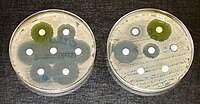
Photo from wikipedia
There are many reactive intermediates found in metabolic pathways. Could these potentially toxic molecules be exploited for an organism's benefit? We propose that during certain microbial infections, the production of… Click to show full abstract
There are many reactive intermediates found in metabolic pathways. Could these potentially toxic molecules be exploited for an organism's benefit? We propose that during certain microbial infections, the production of inherently reactive aldehydes by an infected host is a previously unappreciated innate immune defence mechanism. While there has been a significant focus on the effects of aldehydes on mammalian physiology, the idea that they might be exploited or purposefully induced to kill pathogens is new. Given that aldehydes are made as parts of metabolic programmes that accompany immune cell activation by the cytokine interferon-gamma (IFN-γ) during infections, we hypothesize that aldehydes are among the arsenal of IFN-γ-inducible effectors needed for pathogen control.
Journal Title: Open Biology
Year Published: 2022
Link to full text (if available)
Share on Social Media: Sign Up to like & get
recommendations!